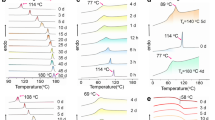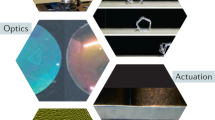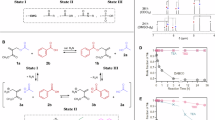Abstract
Liquid-crystal elastomers (LCEs) are a class of actively moving polymers with remarkable practical potential for converting external stimuli into mechanical actuation1. However, real-world applications of LCEs are lacking because macroscopic orientation of liquid-crystal order, which is required for reversible actuations2,3, is hard to achieve in practice. Here we show that the processing bottleneck of LCEs can be overcome by introducing exchangeable links in place of permanent network crosslinks, a concept previously demonstrated for vitrimers4,5. Liquid-crystal elastomers with exchangeable links (xLCEs) are mouldable, allow for easy processing and alignment, and can be subsequently altered through remoulding with different stress patterns, thus opening the way to practical xLCE actuators and artificial muscles. Surprisingly, instead of external-stress relaxation through the creep of non-liquid-crystal transient networks with exchangeable links6,7, xLCEs develop strong liquid-crystal alignment as an alternative mechanism of mechanical relaxation.
This is a preview of subscription content, access via your institution
Access options
Subscribe to this journal
Receive 12 print issues and online access
$259.00 per year
only $21.58 per issue
Buy this article
- Purchase on SpringerLink
- Instant access to full article PDF
Prices may be subject to local taxes which are calculated during checkout





Similar content being viewed by others
References
Warner, M. & Terentjev, E. M. Liquid Crystal Elastomers (Oxford Univ. Press, 2007).
Küpfer, J. & Finkelmann, H. Nematic liquid single-crystal elastomers. Makromol. Chem. Rapid. Commun. 12, 717–726 (1991).
Ohm, C., Brehmer, M. & Zentel, R. Liquid crystalline elastomers as actuators and sensors. Adv. Mater. 22, 3366–3387 (2010).
Montarnal, D., Capelot, M., Tournilhac, F. & Leibler, L. Silica-like malleable materials from permanent organic networks. Science 334, 965–968 (2011).
Capelot, M., Montarnal, D., Tournilhac, F. & Leibler, L. Metal-catalyzed transesterification for healing and assembling of thermosets. J. Am. Chem. Soc. 134, 7664–7667 (2012).
Capelot, M., Unterlass, M., Tournilhac, F. & Leibler, L. Catalytic control of the vitrimer glass transition. ACS Macro Lett. 1, 789–792 (2012).
Lu, Y, Tournilhac, F., Leibler, L. & Guan, Z. Making insoluble polymer networks malleable via olefin metathesis. J. Am. Chem. Soc. 134, 8424–8427 (2012).
Tajbakhsh, A. R. & Terentjev, E. M. Spontaneous thermal expansion of nematic elastomers. Eur. Phys. J. E 6, 181–188 (2001).
Küpfer, J. & Finkelmann, H. Liquid crystal elastomers: Influence of the orientational distribution of the crosslinks on the phase behaviour and reorientation processes. Makromol. Chem. Phys. 195, 1353–1367 (1994).
Broer, D., Boven, J. & Mol, G. N. In situ photopolymerization of oriented liquid-crystalline acrylates, 3. Makromol. Chem. 190, 2255–2268 (1989).
Thomsen, D. L. et al. Liquid crystal elastomers with mechanical properties of a muscle. Macromolecules 34, 5868–5875 (2001).
Lacey, D., Beattie, H., Mitchell, G. R. & Pople, J. A. Orientation effects in monodomain nematic liquid crystalline polysiloxane elastomers. J. Mater. Chem. 8, 53–60 (1998).
Van Oosten, C. L., Bastiaansen, C. M. W. & Broer, D. J. Printed artificial cilia from liquid-crystal network actuators modularly driven by light. Nature Mater. 8, 677–682 (2009).
Yang, H. et al. Micron-sized main-chain liquid crystalline elastomer actuators with ultralarge amplitude contractions. J. Am. Chem. Soc. 131, 15000–15004 (2009).
Ohm, C., Serra, C. & Zentel, R. A continuous flow synthesis of micrometer- sized actuators from liquid crystalline elastomers. Adv. Mater. 21, 4859–4862 (2009).
Li, M-H., Keller, P., Yang, J & Albouy, P-A. An artificial muscle with lamellar structure based on a nematic triblock copolymer. Adv. Mater. 16, 1922–1925 (2004).
Ahir, S. V., Tajbakhsh, A. R. & Terentjev, E. M. Self-assembled shape-memory fibers of triblock liquid-crystal polymers. Adv. Funct. Mater. 16, 556–560 (2006).
Giumberinia, M., Amendolab, E. & Carfagna, C. Lightly crosslinked liquid crystalline epoxy resins: the effect of rigid-rod length and applied stress on the state of order of the cured thermoset. Macromol. Chem. Phys. 198, 3185–3196 (1997).
Lubensky, T. C., Terentjev, E. M. & Warner, M. Layer-network coupling in smectic elastomers. J. Physique 4, 1457–1459 (1994).
Rousseau, I. A. & Mather, P. T. Shape memory effect exhibited by smectic-C liquid crystalline elastomers. J. Am. Chem. Soc. 125, 15300–15301 (2003).
Qin, H. & Mather, P. T. Combined one-way and two-way shape memory in a glass-forming nematic network. Macromolecules 42, 273–280 (2009).
Ahn, S. & Kasi, R. M. Exploiting microphase-separated morphologies of side-chain liquid crystalline polymer networks for triple shape memory properties. Adv. Funct. Mater. 21, 4543–4549 (2011).
Fridrikh, S. V. & Terentjev, E. M. Polydomain–monodomain transition in nematic elastomers. Phys. Rev. E 60, 1847–1857 (1999).
Sanchez-Ferrer, A. & Finkelmann, H. Polydomain–monodomain orientational process in smectic-C main-chain liquid-crystalline elastomers. Macromol. Rapid Commun. 32, 309–315 (2011).
Lu, B-S., Ye, F., Xing, X. & Goldbart, P. M. Phenomenological theory of isotropic-genesis nematic elastomers. Phys. Rev. Lett. 108, 257803 (2012).
Okamoto, T., Urayama, K. & Takigawa, T. Large electromechanical effect of isotropic-genesis polydomain nematic elastomers. Soft Matter 7, 10585–10589 (2011).
Feio, G., Figueirinhas, J. L., Tajbakhsh, A. R. & Terentjev, E. M. Fluctuations and random-anisotropy glass transition in nematic elastomers. Phys. Rev. B 78, 020201R (2008).
Nishikawa, E. & Finkelmann, H. Smectic A liquid single crystal elastomers showing macroscopic in-plane fluidity. Macromol. Rapid Commun. 18, 65–71 (1997).
Beyer, P., Terentjev, E. M. & Zentel, R. Monodomain liquid crystal main chain elastomers by photocrosslinking. Macromol. Rapid Commun. 28, 1485–1490 (2007).
Camargo, C. J. et al. Localised actuation in composites containing carbon nanotubes and liquid crystalline elastomers. Macromol. Rapid Commun. 32, 1953–1959 (2011).
De Haan, L. T., Sánchez-Somolinos, C., Bastiaansen, C. M. W., Schenning, A. P. H. J & Broer, D. J. Engineering of complex order and the macroscopic deformation of liquid crystal polymer networks. Angew. Chem. Int. Ed. 51, 12469–12472 (2012).
Camacho-Lopez, M., Finkelmann, H., Palffy-Muhoray, P. & Shelley, M. Fast liquid-crystal elastomer swims into the dark. Nature Mater. 3, 307–310 (2004).
Ikeda, T., Mamiya, J. & Yu, Y. Photomechanics of liquid-crystalline elastomers and other polymers. Angew. Chem. Int. Ed. 46, 506–528 (2007).
Ji, Y., Huang, Y. Y., Rungsawang, R. & Terentjev, E. M. Dispersion and alignment of carbon nanotubes in liquid crystalline polymers and elastomers. Adv. Mater. 22, 3436–3440 (2010).
Acknowledgements
This research was supported by the National Science Foundation of China (nos 21274075 and 51203086) and the National 973 Project (no. 2011CB935700).
Author information
Authors and Affiliations
Contributions
Y.J. and E.M.T. developed the concept, Y.J. and Y.W. arranged the funding and infrastructure for the project, Z.P., Y.Y. and Y.J. performed the experiments, Q.C. participated in the synthesis of xLCEs, and Y.J., E.M.T. and Y.W. contributed to writing the paper.
Corresponding authors
Ethics declarations
Competing interests
The authors declare no competing financial interests.
Supplementary information
Supplementary Information
Supplementary Information (PDF 1051 kb)
Rights and permissions
About this article
Cite this article
Pei, Z., Yang, Y., Chen, Q. et al. Mouldable liquid-crystalline elastomer actuators with exchangeable covalent bonds. Nature Mater 13, 36–41 (2014). https://doi.org/10.1038/nmat3812
Received:
Accepted:
Published:
Issue Date:
DOI: https://doi.org/10.1038/nmat3812



